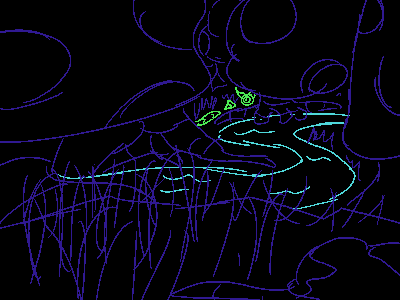
The Fungal Wastes are the outermost ring of Stem Island's environment. Huge forests of fungal origin, strange eternal saplings made of glowing wood, and electricity conducting ferns exist out here in the fertile soil. Various rivers flow through the humid jungle, the water full of small shrimp and surrounded by buzzing insects.
Its ecosystem consists of small insectoid and aquatic life and huge, centuries-old beasts that munch whatever is in front of them. Many species have been hunted to extinction by the two dominant apex predators, Stem Rams and Stem Slimes, leaving the majority of the living creatures left with whatever they wouldn't, or couldn't, hunt effectively.
Throughout the jungle, a few Stem Ram tribes that denied the Era of Tribal Peace and Era of External Expansion still exist. Their lives are harder than those of their ancestors due to the lack of good meals and limited hunting grounds, but they get along by strictly hunting the plentiful Stem Slimes hives.
Various abandoned structures dating from all eras can be found littered about the wastes, many of which have been claimed by opportunistic Stem Slime hives.
Though Stem City lost their tribal people's history long ago, the Fungal Wastes' Stem Ram tribes have one shared myth going back as long as their chiefs can remember: They describe foggy mushroom men walking between the stems and vanishing into unknown smoke. This arcane, enlightened race gave the Stem Rams the gift of fire to defend themselves from the monstrous slimes several eons ago.
The Fungal Wastes used to be full of crazy amounts of varying creatures and fauna. However, as Stem Rams evolved, they started to overhunt. Unable to find food, they traveled inward towards the Fungal Plains for fresher lands. Civilization soon formed outside the Fungal Wastes, leaving it a wild and untamed area.
The Grand Shroom's huge stems ripping through the jungle and Stem City's deforestation of the environment surrounding their Stemrail system acted as massive environmental walls, separating previously unified ecosystems. Because of this, the now isolated chunks of Fungal Wastes have begun to develop their own, unique forms of life...